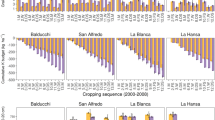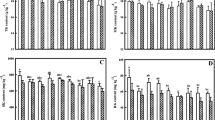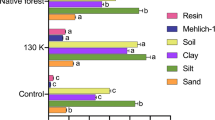Abstract
Soil-plant potassium (K) dynamics were studied using a long-term field experiment in order to evaluate the plant performance and K delivering capacity of the soil parent material. Rye grass (Lolium perenne L.) based rotations on a loamy sand derived from granitic bedrock were studied over 30 years with two K-fertilisation regimes, nil (K0) and 65 kg K ha−1 yr−1. Mineralogical and chemical methods were combined to identify and quantify soil K resources including the partitioning of K between minerals. Two or three cuts were taken annually and herbage yield and composition together with exchangeable soil K were analysed. Herbage yield declined with time and significantly reduced when the K concentrations approached 1%. The grass K concentration also declined over time and stabilized at around 0.5–0.7% (dw) in K0 in all cuts. Input-output mass balances showed an accumulated net K off-take (deficit) of 1,100 kg ha−1, i.e. 35 kg ha−1 yr−1. With an exchangeable K pool of 100 kg ha−1 (in the rooting zone 0–40 cm) this indicated a substantial release of K from mineral sources, most probably biotite and hydrobiotite. Assuming a similar net off-take was continued then this particular mineralogical K source would be depleted within two centuries. The study illustrates the strength of combining long-term field experimental data with state of the art quantitative mineralogical methods in order to assess site-specific resources which can form a basis to evaluate the sustainability of different management practices.



Similar content being viewed by others
References
Adamo P, McHardy WJ, Edwards AC (1998) SEM observations in the back-scattered mode of the soil-root zone of Brassica napus (cv. Rafal) plants grown at a range of soil pH values. Geoderma 85:357–370
Alfaro MA, Jarvis SC, Gregory PJ (2003) Potassium budgets in grassland systems as affected by nitrogen and drainage. Soil Use Manage 19:89–95
Andersson S, Simonsson M, Mattsson L, Edwards AC, Öborn I (2007) Response of soil exchangeable and crop potassium concentrations to variable fertiliser and cropping regimes in long-term field experiments on different soil types. Soil Use Manage 23:10–19
Andrist-Rangel Y (2008) Quantifying mineral sources of potassium in agricultural soils. Doctoral Thesis No 2008:53, Faculty of Natural Resources and Agricultural Sciences, Acta Universitatis Agriculturae Sueciae, Uppsala
Andrist-Rangel Y, Simonsson M, Andersson A, Öborn I, Hillier S (2006) Mineralogical budgeting of potassium in soil: a basis for understanding standard measures of reserve potassium. J Plant Nutr Soil Sci 169:605–615
Andrist-Rangel Y, Edwards AC, Hillier S, Öborn I (2007) Long-term K dynamics in organic and conventional mixed cropping systems as related to management and soil properties. Agric Ecosyst Environ 122:413–426
Andrist-Rangel Y, Hillier S, Öborn I, Lilly A, Towers W, Edwards AC, Paterson E (2010) Assessing potassium reserves in northern temperate grassland soils: a perspective based on quantitative mineralogical analysis and aqua-regia extractable potassium. Geoderma (accepted)
Askegaard M, Eriksen J (2002) Exchangeable potassium in soil as indicator of potassium status in an organic crop rotation on loamy sand. Soil Use Manage 18:84–90
Askegaard M, Eriksen J (2008) Residual effect and leaching of N and K in cropping systems with clover and ryegrass catch crops on a coarse sand. Agric Ecosyst Environ 123:99–108
Askegaard M, Eriksen J, Olesen JE (2003) Exchangeable potassium and potassium balances in organic crop rotations on a coarse sand. Soil Use Manage 19:96–103
Askegaard M, Eriksen J, Johnston AE (2004) Sustainable management of potassium. In: Schjønning P, Elmholt S, Christensen BT (eds) Managing soil quality - challenges in modern agriculture. CAB International, Wallingford, pp 85–102
Barré P, Velde B, Catel N, Abbadie L (2007) Soil-plant potassium transfer; impact of plant activity on clay minerals as seen from X-ray diffraction. Plant Soil 292:137–146
Barré P, Velde B, Fontaine C, Catel N, Abbadie L (2008) Which 2:1 clay minerals are involved in the soil potassium reservoir? Insights from potassium addition or removal experiments on three temperate grassland soil clay assemblages. Geoderma 146:216–223
Barré P, Berger G, Velde B (2009) How element translocation by plants may stabilize illitic clays in the surface of temperate soils. Geoderma 151:22–30
Bedrossian S, Singh B (2004) Potassium adsorption characteristics and potassium forms in some New South Wales soils in relation to early senescence in cotton. Aust J Soil Res 42:747–753
Bell MJ, Moody PW, Harch GR, Compton B, Want PS (2009) Fate of potassium fertiliser applied to clay soils under rainfed grain cropping in south-east Queensland, Australia. Aust J Soil Res 47:60–73
Bengtsson H, Öborn I, Jonsson S, Nilsson I, Andersson A (2003) Field balances of some mineral nutrients and trace elements in organic and conventional dairy farming—a case study at Öjebyn, Sweden. Eur J Agron 20:101–116
Berry PM, Stockdale EA, Sylvester-Bradley R, Philipps L, Smith KA, Lord EI, Watson CA, Fortune S (2003) N, P and K budgets for crop rotations on nine organic farms in the UK. Soil Use Manage 19:112–126
Brady NC, Weil RR (1996) The nature and properties of soils, 11th edn. Prentice-Hall, Upper Saddle River
Broad HJ, Hough MN (1993) The growing and grazing season in the United Kingdom. Grass Forage Sci 48:26–37
Edwards AC, Mackie-Dawson LA, Millard P, Shepherd H, Reid ME, Webster L, Pratt S, Stott C (1987) Quantify the availability of soil and fertiliser phosphorous to crops by chemical methods and field trials and assess interactions with acidity. In: Macaulay Land Use Research Institute, Report of Work in Progress 1987, Craigiebuckler, Aberdeen, pp 171–173
Egnér H, Riehm H, Domingo WR (1960) Untersuchungen über die Chemische Bodenanalyse als Grundlage für die Beurteilung des Nährstoffzustandes der Böden. Ann Roy Agr Coll Sweden 26:199–215
Fanning DS, Keramidas VZ, El-Desoky MA (1989) Micas. In: Dixon JB, Weed SB (eds) Minerals in soil environments, 2nd edn. SSSA Book Series No 1, Madison, WI, pp 551–634
Fortune S, Robinson JS, Watson CA, Philipps L, Conway JS, Stockdale EA (2005) Response of organically managed grassland to available phosphorus and potassium, in the soil and supplementary fertilization: field trials using grass-clover leys cut for silage. Soil Use Manage 21:370–376
Foy RH, Bailey JS, Lennox SD (2002) Mineral balances for the use of phosphorus and other nutrients by agriculture in Northern Ireland from 1925 to 2000—methodology, trends and impacts of losses to water. Irish J Agr Food Res 41:247–263
Ghorayshi M, Lotse E (1986) Quantity intensity relationships of potassium in 3 Swedish soils. Swed J Agr Res 16:57–65
Glentworth RS, Muir JW (1963) The soils around Aberdeen, Inverurie, and Fraserburgh. Soil Survey of Scotland Memoirs. The Macaulay Institute for Soil Research, Aberdeen
Goulding KTW, Loveland PJ (1986) The classification and mapping of potassium reserves in soils of England and Wales. J Soil Sci 37:555–565
Gustafson GM, Salomon E, Jonsson S (2007) Barn balance calculations of Ca, Cu, K, Mg, Mn, N, P, S and Zn in a conventional and organic dairy farm in Sweden. Agric Ecosyst Environ 119:160–170
Haak E (1981) Nutrient uptake from subsoil by cereals. In: Agricultural yield potentials in continental climates. Proceedings of the 16th Colloquium of the International Potash Institute, Basel
Hanson AA (1990) Practical handbook of agricultural science. CRC, Boca Raton
Heming SD (2004) Potassium balances for arable soils in southern England 1986–1999. Soil Use Manage 20:410–417
Hillier S (1999) Use of an air brush to spray dry samples for X-ray powder diffraction. Clay Miner 34:127–135
Hillier S (2003) Quantitative analysis of clay and other minerals in sandstones by X-ray powder diffraction (XRPD). Int Assoc Sedimentol Spec Publ 34:207–245
Hinsinger P, Jaillard B (1993) Root-induced release of interlayer potassium and vermiculitization of phlogopite as related to potassium depletion in the rhizosphere of ryegrass. J Soil Sci 44:525–534
Hodson ME, Langan SJ, Wilson MJ (1997) A critical evaluation of the use of the PROFILE model in calculating mineral weathering rates. Water Air Soil Poll 98:79–104
Holmqvist J, Falk Øgaard A, Öborn I, Edwards AC, Mattsson L, Sverdrup H (2003) Application of the PROFILE model to estimate potassium release from mineral weathering in Northern European agricultural soils. Eur J Agron 20:149–163
Huang PM (1989) Feldspars, olivines, pyroxenes, and amphiboles In: Dixon JB, Weed SB (eds) Minerals in soil environments, 2nd edn. SSSA Book Series No 1, Madison, WI, pp 975–1050
Kayser M, Isselstein J (2005) Potassium cycling and losses in grassland systems: a review. Grass Forage Sci 60:213–224
Kuhlmann H (1990) Importance of the subsoil for the K-nutrition of crops. Plant Soil 127:129–136
MAFF (1986) The analysis of agricultural materials, 3rd edn. Reference Book 427. Defra, Information Resource Centre, London
Manning DAC (2010) Mineral sources of potassium for plant nutrition. A review. Agron Sustain Dev 30:281–294
McGrath SP (1987) Computerized quality control, statistics and regional mapping of the concentrations of trace and major elements in the soils of England and Wales. Soil Use Manage 3:31–38
McGrath SP, Cunliffe CH (1985) A simplified method for the extraction of the metals Fe, Zn, Cu, Ni, Cd, Pb, Cr, Co, and Mn from soils and sewage sludges. J Sci Food Agric 36:794–798
Mclean EO, Watson ME (1985) Soil measurements of plant-available potassium. In: Munson (ed) Potassium in agriculture, ASA-CSSA-SSSA Madison, WI, 277–308
MISR/SAC (1985) Advisory soil analysis and interpretation. The Macaulay Institute for Soil Research and Scottish Agricultural Colleges Bulletin 1:1–13
Murashkina MA, Southard RJ, Pettygrove GS (2007) Silt and fine sand fractions dominate K fixation in soils derived from granitic alluvium of the San Joaquin Valley, California. Geoderma 141:283–293
Newman ACD (1969) Cation exchange properties of micas. I. The relation between mica composition and potassium exchange in solutions of different pH. J Soil Sci 20:357–373
Norrish K, Hutton JT (1969) An accurate X-ray spectrographic method for the analysis of a wide range of geological samples. Geochim Cosmochim Acta 33:431–453
Öborn I, Andrist-Rangel Y, Askegaard M, Grant CA, Watson CA, Edwards AC (2005a) Critical aspects of potassium management in agricultural production systems. Soil Use Manage 21:102–112
Öborn I, Modin-Edman A-K, Bengtsson H, Gustafson GM, Salomon E, Nilsson SI, Holmqvist J, Jonsson S, Sverdrup H (2005b) A systems approach to assess farm-scale nutrient and trace element dynamics: A case study at the Öjebyn dairy farm. Ambio 34:301–310
Øgaard AF, Krogstad T, Lunnan T (2002) Ability of some Norwegian soils to supply grass with potassium (K)—soil analyses as predictors of K supply from soil. Soil Use Manage 18:412–420
Omotoso O, Mccarty DK, Hillier S, Kleeberg R (2006) Some successful approaches to quantitative mineral analysis as revealed by the 3rd Reynolds Cup contest. Clay Clay Miner 54:748–760
Pal Y, Wong MTF, Gilkes RJ (1999) The forms of potassium and potassium adsorption in some virgin soils from south-western Australia. Aust J Soil Res 37:695–709
Reid JM, MacLeod DA, Cresser MS (1981) Factors affecting the chemistry of precipitation and river water in an upland catchment. J Hydrol 50:129–145
Robert M (1992) K-fluxes in soils in relation to parent material and pedogenesis in tropical, temperate and arid climates. Proceedings of the 23rd Colloquium of the International Potash Institute, Basel, pp 25–44
Rowell DL (1994) Soil science methods and applications. Longman, Singapore, pp 66–67
Simonsson M, Andersson S, Andrist-Rangel Y, Hillier S, Mattsson L, Öborn I (2007) Potassium release and fixation as a function of fertilizer application rate and soil parent material. Geoderma 140:188–198
Sinclair AH (1979a) Availability of potassium to ryegrass from Scottish Soils I. Effects of intensive cropping on potassium parameters. J Soil Sci 30:757–773
Sinclair AH (1979b) Availability of potassium to ryegrass from Scottish Soils II. Uptake of initially non-exchangeable potassium. J Soil Sci 30:775–783
Singh B, Goulding KWT (1997) Changes with time in the potassium content and phyllosilicates in the soil of the Broadbalk continous whear experiment at Rothamsted. Eur J Soil Sci 48:651–659
Skinner RJ, Todd AD (1998) Twenty-five years of monitoring pH and nutrient status of soils in England and Wales. Soil Use Manage 14:162–169
Smaling EMA, Oenema O, Fresco LO (eds) (1999) Nutrient Disequilibria in Agroecosystems. Concepts and case studies, CABI Publishing
Sparks DL (1987) Potassium Dynamics in Soils. In: Stewart BA (ed) Advances in soil science. Springer-Verlag, New York, pp 1–63
Sparks DL, Huang PM (1985) Physical chemistry of soil potassium. In: Munson (ed) Potassium in agriculture, ASA-CSSA-SSSA Madison, WI, pp 201–276
Sverdrup H, Warfvinge P (1993) Calculating field weathering rates using a mechanistic geochemical model PROFILE. Appl Geochem 8:273–283
Systat (1998) SYSTAT for Windows: Statistics Version 8.0, Evanston IL Systat Inc 1086pp
Thomas GW (1982) Exchangeable cations. In: Page AL, Miller RH, Keeney DR (eds) Methods of soil analysis, Part 2, Agronomy Monograph no 9 2nd Ed, pp 159–165
Thompson ML, Ukrainczyk L (2002) Micas. In: Dixon JB, Schulze DG (eds) Soil mineralogy with environmental applications, Series No 7. SSSA Book, Madison, pp 431–466
Warfvinge P, Sverdrup H (1992) Calculating critical loads of acid deposition with PROFILE—a steady state soil chemical model. Water Air Soil Poll 63:119–143
Watson CA, Bengtsson H, Ebbesvik M, Løes A-K, Myrbeck A, Salomon E, Schroeder J, Stockdale EA (2002) A review of farm-scale nutrient budgets for organic farms as a tool for management of soil fertility. Soil Use Manage 18:264–273
Whitehead DC (2000) Nutrient elements in grassland. Soil-plant-animal relationships, CAB International Wallingford UK
Wilson MJ (1992) K-bearing minerals and their K-release rates in different climates. Proceedings of the 23rd Colloquium of the International Potash Institute, Basel, pp 44–57
Wilson MJ (2004) Weathering of the primary rock-forming minerals: processes, products and rates. Clay Miner 39:233–266
Witter E, Johansson G (2001) Potassium uptake from the subsoil by green manure crops. Biol Agric Hortic 19:127–141
Wulff F, Schulz V, Jungk A, Claassen N (1998) Potassium fertilization on sandy soils in relation to soil test, crop yield and K-leaching. Z Pflanz Bodenkunde 161:591–599
Acknowledgements
JAM Ross, D Nelson and Y Cook for field and laboratory assistance. The long-term funding from Scottish Government Rural, Environment and Research Analysis Department (RERAD) is acknowledged.
Author information
Authors and Affiliations
Corresponding author
Additional information
Responsible Editor: Philippe Hinsinger.
Rights and permissions
About this article
Cite this article
Öborn, I., Edwards, A.C. & Hillier, S. Quantifying uptake rate of potassium from soil in a long-term grass rotation experiment. Plant Soil 335, 3–19 (2010). https://doi.org/10.1007/s11104-010-0429-8
Received:
Accepted:
Published:
Issue Date:
DOI: https://doi.org/10.1007/s11104-010-0429-8




